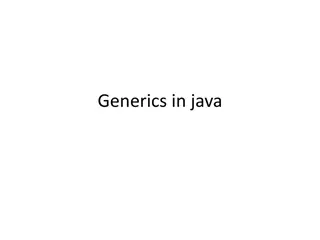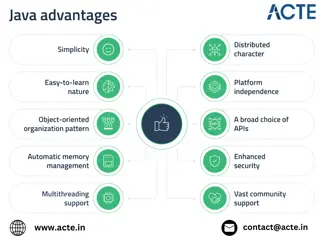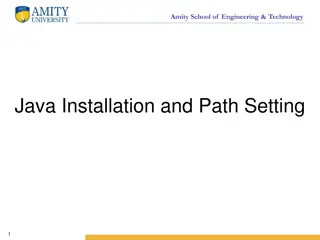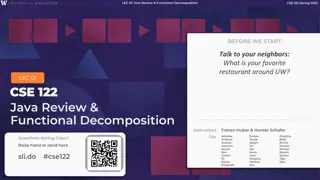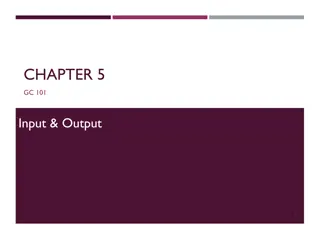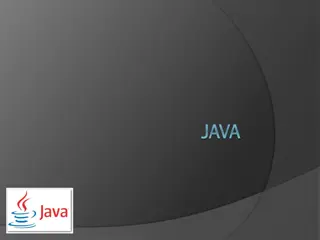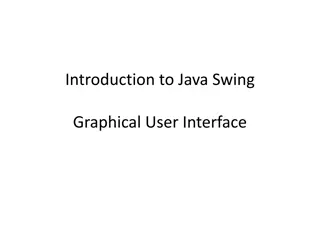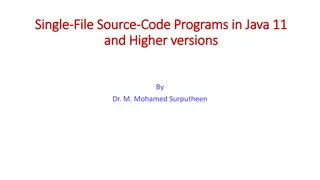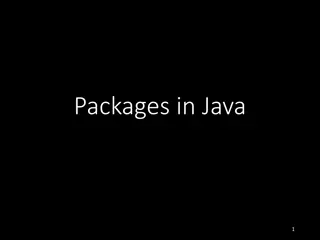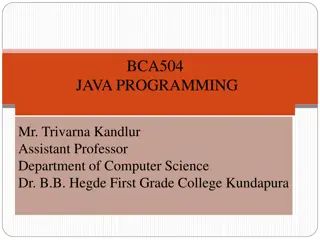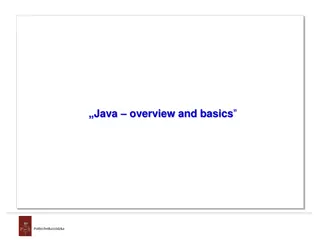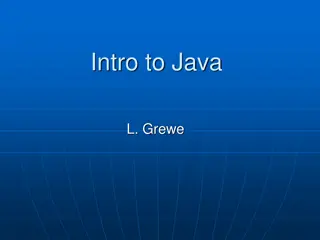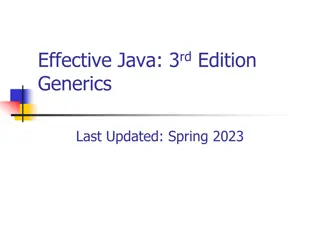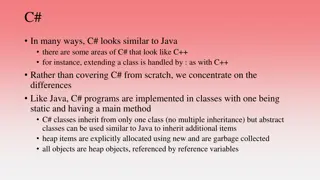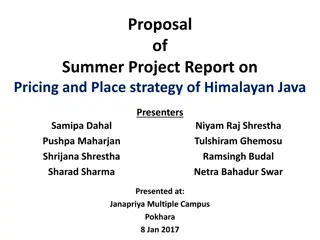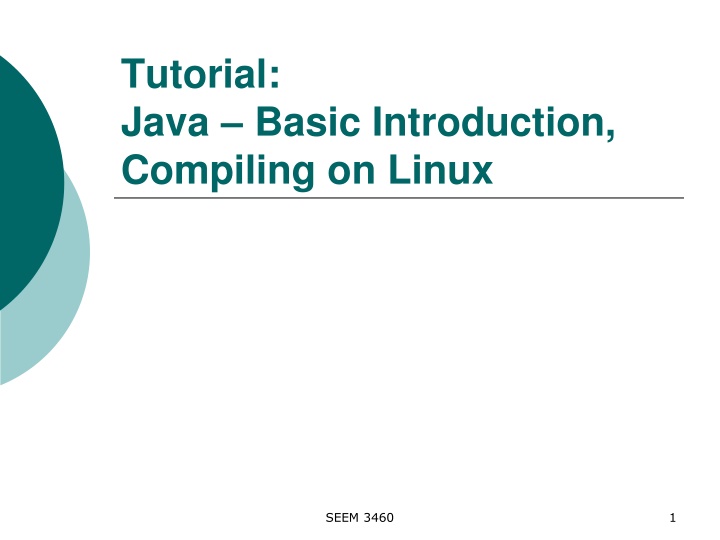
Introduction to Java Programming: Basics and Compilation on Linux
Learn about the fundamentals of Java programming, including its history, structure, and compilation process on Linux. Java's unique features, such as Write Once, Run Anywhere (WORA), make it a popular choice for developers. Explore Java's translation process from source code to bytecode and how to compile and run Java programs on Unix systems.
Download Presentation

Please find below an Image/Link to download the presentation.
The content on the website is provided AS IS for your information and personal use only. It may not be sold, licensed, or shared on other websites without obtaining consent from the author. If you encounter any issues during the download, it is possible that the publisher has removed the file from their server.
You are allowed to download the files provided on this website for personal or commercial use, subject to the condition that they are used lawfully. All files are the property of their respective owners.
The content on the website is provided AS IS for your information and personal use only. It may not be sold, licensed, or shared on other websites without obtaining consent from the author.
E N D
Presentation Transcript
Tutorial: Java Basic Introduction, Compiling on Linux SEEM 3460 1
Java Java was created by Sun Microsystems, Inc. The latest version is Java 8. "write once, run anywhere (WORA) compiled Java code can run on all platforms that support Java without the need for recompilation. Java virtual machine (JVM) one of the most popular languages, particularly for web applications, 9 million developers. The language derives much of its syntax from C and C++, but it has fewer low-level facilities than either of them. SEEM 3460 2
Java Program Structure A Java source file contains at least a class A Java application always contains a method called main public class HelloWorld { public static void main(String []args){ System.out.println("Hello World"); } } SEEM 3460 3
Java Translation The Java compiler translates Java source code into a special representation called bytecode Java bytecode is not the machine language for any traditional CPU Another software tool, called an interpreter, translates bytecode into machine language and executes it Therefore the Java compiler is not tied to any particular machine Java is considered to be architecture-neutral 4
Java Translation Java source code machine code for target machine 1 Bytecode interpreter Java compiler Java bytecode machine code for target machine2 Bytecode interpreter 5
Compiling and Running Java on Unix We can compile a Java program under Unix by: cuse93> javac Countdown.java If the compilation is successful, a bytecode file called Countdown.class will be generated. To invoke Java bytecode interpreter, we can: cuse93> java Countdown Three Two One.. Zero Liftoff! Houston, we have a problem. wget http://www.se.cuhk.edu.hk/~seem3460/tutorial/lab/Countdown.java SEEM 3460 7
//************************************************ // Countdown.java // // Demonstrates the difference between print and println. //************************************************ public class Countdown { //----------------------------------------------------------------- // Prints two lines of output representing a rocket countdown. //----------------------------------------------------------------- public static void main (String[] args) { System.out.print ("Three... "); System.out.print ("Two... "); System.out.print ("One... "); System.out.print ("Zero... "); System.out.println ("Liftoff!"); // appears on first output line System.out.println ("Houston, we have a problem."); } } SEEM 3460 8
Interactive Programs Programs generally need input on which to operate The built-in Scanner class provides convenient methods for reading input values of various types A Scannerobject (called scan) can be set up to read input from various sources, including the user typing values on the keyboard Keyboard input is represented by the System.in object wget http://www.se.cuhk.edu.hk/~seem3460/tutorial/lab/Echo.java SEEM 3460 9
//***********************************************************//*********************************************************** // Echo.java // // Demonstrates the use of the nextLine method of the Scanner class // to read a string from the user. //*********************************************************** import java.util.Scanner; public class Echo { //----------------------------------------------------------------- // Reads a character string from the user and prints it. //----------------------------------------------------------------- public static void main (String[] args) { String message; Scanner scan = new Scanner (System.in); System.out.println ("Enter a line of text:"); message = scan.nextLine(); System.out.println ("You entered: \"" + message + "\""); } } SEEM 3460 10
Echo.java - Sample Execution The following is a sample execution of Echo.class cuse93> java Echo Enter a line of text: This is a line You entered: This is a line SEEM 3460 11
Input Tokens Unless specified otherwise, white space is used to separate the elements (called tokens) of the input White space includes space characters, tabs, new line characters The next method of the Scanner class reads the next input token and returns it as a string Methods such as nextInt and nextDouble read data of particular types See GasMileage.java wget http://www.se.cuhk.edu.hk/~seem3460/tutorial/lab/GasMileage.java SEEM 3460 12
//*************************************************************//************************************************************* // GasMileage.java // // Demonstrates the use of the Scanner class to read numeric data. //************************************************************* import java.util.Scanner; public class GasMileage { //----------------------------------------------------------------- // Calculates fuel efficiency based on values entered by the // user. //----------------------------------------------------------------- public static void main (String[] args) { int miles; double gallons, mpg; Scanner scan = new Scanner (System.in); System.out.print ("Enter the number of miles: "); miles = scan.nextInt(); System.out.print ("Enter the gallons of fuel used: "); gallons = scan.nextDouble(); mpg = miles / gallons; System.out.println ("Miles Per Gallon: " + mpg); } } SEEM 3460 13
GasMileage.java - Sample Execution The following is a sample execution of GasMileage.class cuse93> java GasMileage Enter the number of miles: 34 Enter the gallons of fuel used: 17 Miles Per Gallon: 2.0 SEEM 3460 14
Development Environments There are many programs that support the development of Java software, including: Sun Java Development Kit (JDK) Sun NetBeans IBM Eclipse Borland JBuilder MetroWerks CodeWarrior BlueJ jGRASP Though the details of these environments differ, the basic compilation and execution process is essentially the same SEEM 3460 15


